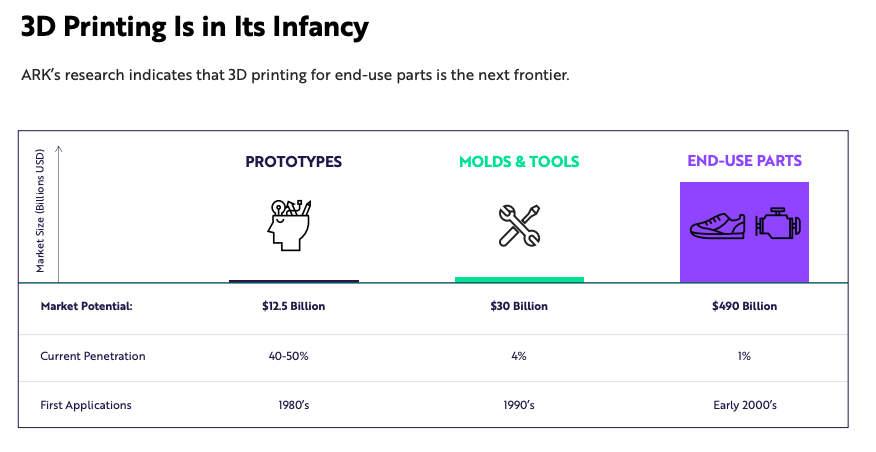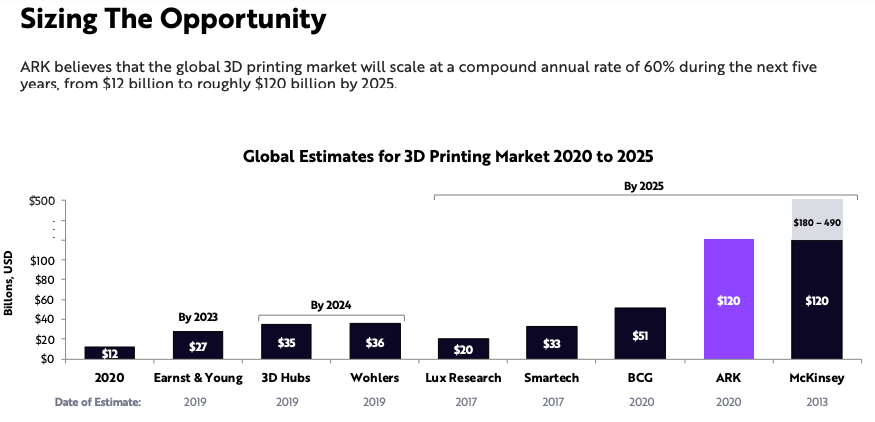ARK Investment Management LLC is the only investment management firm that offers an actively managed exchange-traded fund (ETF) dedicated to 3D printing, making it a unique player in the world of additive manufacturing (AM) finance. Established in 2016, the Total 3D-Printing Index (PRNT) is one of the few ways that individuals can invest in the AM market as a whole without purchasing shares in separate 3D printing stocks.
An ETF is a collection of stocks tied to a specific sector or commodity but that can be bought or sold on the market in the same way a traditional stock can. When ETFs are actively managed, a team or expert is making decisions about the stocks within the fund’s portfolio based on the performance of companies behind them or the economic markets as a whole.
ARK was founded in 2014 by Cathie Wood, a well-known investor who suggested the idea of actively managed ETFs based on disruptive technologies while working as chief investment officer for asset management firm AllianceBernstein. When the company deemed the concept too risky, she created ARK, now a roughly $23 billion-fund tracking such tech firms as Tesla and Square.
Since the beginning, ARK looked at 3D printing, establishing the Total 3D-Printing Index (PRNT) just two years after the company’s founding. ARK’s fund uses a replication strategy, investing in the securities of an index kept by a German company called Solactive, the world’s 13th largest provider of stock indices (The oldest index is the famous S&P 500, tracking 500 companies with market caps of over $4.6 billion and totaling nearly $400 billion in assets). By replicating the Solactive 3D-Printing Index, PRNT is passively managed, with changes made to the index and, therefore to PRNT, semi-annually.
As for PRNT, the universe is made up of about 50 percent 3D printer manufacturers, followed by 30 percent CAD and simulation software businesses, 13 percent service bureaus, five percent scanning and measurement, and two percent materials. Whereas a mutual fund might require something like a $10,000 minimum to invest, the PRNT index is an opportunity for more ordinary consumers to put funds toward a technological segment for which they anticipate growth.
Other benefits include the fact that ETFs are somewhat more transparent than other funds, in that the holdings can be viewed publicly online daily, in contrast to another private fund that might send a semi-annual statement to investors. ETFs also generally have lower fees. For PRNT, ARK takes a 0.6 percent cut, compared to a mutual fund’s fees of closer to two percent.
Every quarter, the ETF is rebalanced and every six months, ARK will suggest changes to the stocks in the fund, based on its research. Solactive, however, has the final say. With a minimum market cap threshold of $80 million and a liquidity threshold, Solactive examines the average daily volume of how a stock has traded over the course of three months, with a minimum volume exceeding $200,000. If the stock is large and liquid enough, it may be considered for the index. The PRNT fund is then rebalanced based on the index.
The companies in the fund are also scored based on such characteristics as management team, product portfolio, and execution. ARK hopes that the stocks within their funds will double over a five-year period. Ideally, these should make for a relatively balanced collection of firms involved in AM with the potential for double growth over the next five years.
Looking through the most recent list of holdings under the PRNT index, as of December 1, 2021, you’ll see nearly 60 firms comprised of everyone from Stratasys and 3D Systems to Hexagon and Oerlikon with their respective weight percentages. Desktop Metal has the highest weight in the list at a whopping 7.60 percent, with the next in line, HP, weighted at 5.17 percent.
This compares to a company like Align, known for the use of 3D printing in its manufacturing of invisible braces, which is weighted at 1.35 percent. In total, the fund manages $472.9 million in assets, with a weighted average market cap of $120 billion and median market cap of $5 billion. Since its inception in July of 2016, it has seen a positive market price change of 83.99%.
The consumer hype bubble turned many off of the technology, but that that was not the case for ARK. As evidenced by this chart from an ARK slide deck, 3D printing has barely begun to penetrate the market for end-use parts. The investment firm estimates the total addressable opportunity for this market to be worth nearly $500 billion, of which the current penetration by AM has only been about one percent.

Image courtesy of ARK.
However, since that hype bubble, the 3D printing industry has evolved significantly, with AM investment shifting from a consumer- to industry-focused technology, lending credence to ARK’s estimates.
For instance, 3D Systems dissolved its consumer line, while Stratasys began outsourcing the production of its MakerBot 3D printers. Now, not only have these stalwarts redirected their investments toward industrial 3D printing—3D Systems focusing heavily on its Figure 4 ecosystem for production and Stratasys developing a mass sintering platform—but numerous giants from outside of AM have entered into the space, making significant waves.
At first, this was signified by GE Additive, which acquired two important metal 3D printer manufacturers and is developing a metal binder jetting system, and HP, which has released a polymer sintering and metal binder jetting machine. However, numerous chemical companies have been shaping the industry a great deal. Specifically, BASF has made some important acquisitions, such as that of Sculpteo, and opened up a spare parts printing business.
Now, there is clearly a lot of attention being paid to the industry. The participation by major corporations in the space was amplified by the COVID-19 pandemic and the role that AM played in managing the supply chain disruptions that resulted. We reported numerous cases in which 3D printing was able to help produce replacement parts, molding, and medical components, showcasing its potential for manufacturing as a whole.
This reintroduced the technology to a number of firms that were left in the lurch. The technology proved valuable as a stopgap measure both for the production of medical supplies to address the pandemic and traditional manufacturing. As a result, we’ve seen numerous announcements related to SPAC mergers and traditional IPOs, as well as increased mergers and acquisitions more generally.
In the past, reverse mergers would be considered with greater skepticism as small, sometimes unknown companies would use existing public entities in order to bypass regulations associated with IPOs. For instance, Tinkerine and Graphene Labs used reverse mergers to get onto less regulated markets. A reverse merger by 3D Group in Australia showcased the use of such a tactic to perform a pump-and-dump schemes.
More recently, the spat of SPACs that the industry has witnessed represent a laxer attitude toward reverse mergers. Companies that perform these operations don’t need to go through the typical IPO process and don’t have to file the same documents. A company with decent financials, and transparency about those financials, can likely use a SPAC to obtain a single, guaranteed source of capital. However, businesses with less transparent operations can also pursue SPACs without the rigors of a traditional IPO, in which a company must build up a collection of backers, convince a group of investors to participate, and go through banks in order to launch successfully.

Image courtesy of ARK.
Due to the recent excitement, individual investors may be eager to get into the game. According investors we’ve spoken to, including SmarTech Analysis’s own Scott Dunham, this is no hype bubble we’re experiencing. The technology is much more mature. By investing in the market as a whole, ARK hopes to capitalize on this evolution. In fact, it believes that the segment will reach a whopping $120 billion by 2025, which is more than others have anticipated. Whether or not it will get to that point is another story altogether.
Subscribe to Our Email Newsletter
Stay up-to-date on all the latest news from the 3D printing industry and receive information and offers from third party vendors.
You May Also Like
3D Printing Webinar and Event Roundup: May 5, 2024
We’ve got a busy week of 3D printing events ahead of us, in Texas, Florida, Washington, D.C., Shanghai, and more. Webinar offerings will cover medical models, PolyJet 3D printing, additive...
Kings 3D Introduces Five New 3D Printers Ahead of TCT Asia
In the weeks leading up to TCT Asia, the 3D printing scene in China is already bustling with activity and product promotion. Among the companies taking part is stereolithography (SLA)...
Why Corrosive Resistant Materials Are Important to the Success of 3D Printing Across Industries
The adoption of additive manufacturing (AM) is accelerating across many major industries. As this technological shift unfolds, the importance of corrosion resistance has emerged as a challenge for 3D printing...
Seurat Qualifies Low-carbon Stainless Steel from 6K for Metal 3D Printing
Just a few days ago, I wrote that Velo3D’s qualification of Continuum’s recycled powder could “spark a trend toward qualifying every single powder in recycled form for use in machines...































